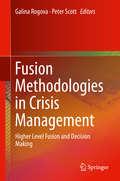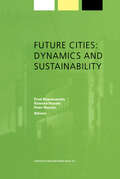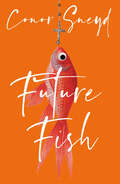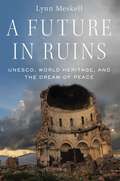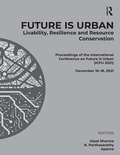- Table View
- List View
Fungi in Polar Regions
by Masaharu Tsuji Tamotsu HoshinoFungi that inhabit polar-region can grow and decompose organic compounds under subzero temperatures play important roles in the nutrient cycle of polar-region ecosystems. Thus, changes in the mycoflora affect the ecological recycling in these regions, and understanding the cold-adaptation strategies of fungi under extreme environments is critical for a better understanding of polar-region ecosystems. Due to their ability to survive under extreme environments, fungi in polar-region are seen to show potential for utilization in biotechnologies. This book presents our current understanding of the mycoflora in polar-region and their cold adaptation strategies, and applied studies using their abilities.
Fungi in Polar Regions
by Masaharu Tsuji Tamotsu HoshinoFungi that inhabit polar-region can grow and decompose organic compounds under subzero temperatures play important roles in the nutrient cycle of polar-region ecosystems. Thus, changes in the mycoflora affect the ecological recycling in these regions, and understanding the cold-adaptation strategies of fungi under extreme environments is critical for a better understanding of polar-region ecosystems. Due to their ability to survive under extreme environments, fungi in polar-region are seen to show potential for utilization in biotechnologies. This book presents our current understanding of the mycoflora in polar-region and their cold adaptation strategies, and applied studies using their abilities.
Fungi of Antarctica: Diversity, Ecology and Biotechnological Applications
by Luiz Henrique RosaThis book focuses on the fungi found in one of the most pristine regions on Earth: Antarctica. It discusses the fungal occurrence in all substrates of the region, including soil, seawater, lake and marine sediments, rocks, ice, and snow. It also addresses the impact of climate changes on these organisms, the genomic techniques developed to study them, and how a number of compounds, such as antibiotics and enzymes, produced by the Antarctic fungi can be used in medicine, agriculture and the chemical industry.
Fungicides in Practice
by Richard P. Oliver Professor Janna L BeckermanThis is an up-to-date guide on the science and practice of disease control based on fungicides in horticulture and broad acre agriculture. It describes how conventional, organic and biological fungicides are discovered, how they work and how resistance evolves. Chapters on formulation, mode of action, mobility and application inform decisions about which fungicides to use, when to use them, and how to rotate (or tank-mix) them, to manage both plant disease and fungicide resistance. A chapter on experimental design of fungicide trials aids practitioners in designing their own trials to evaluate how effective products are for their plant disease problem. Based on the successful 2014 book of Fungicides in Crop Protection this edition has four entirely new chapters, and extensive updates to the other nine chapters. The contents include: · Fungicide markets, discovery and performance. · Modes of action and spectrum. · Biological crop protection, and organic cultivation. · Fungicide formulation, mobility and application. · Experimental design of fungicide trials and their analysis. · Fungicide resistance. · Legislation and regulation. Written for crop protection professionals and scientists, growers, agronomists and consultants, the book is also suitable for students of agriculture and agronomy.
Funktionentheorie 2 (Springer-Lehrbuch)
by Reinhold RemmertAus den Besprechungen: "Der nunmehr vorliegende zweite Band der Funktionentheorie erfüllt voll die Erwartungen, die der erste Band geweckt hat. Wieder beeindrucken vor allem die hochinteressanten historischen Bemerkungen zu den einzelnen Themenkreisen, als besonderer Leckerbissen wird das Gutachten von Gauß über Riemanns Dissertation vorgestellt... Jedes einzelne Kapitel enthält ausführliche Literaturangaben. Ferner werden oft sehr aufschlußreiche Hinweise auf die Funktionentheorie mehrerer Veränderlicher gegeben. Die vielen Beispiele und Übungsaufgaben bilden eine wertvolle Ergänzung der brillant dargelegten Theorie. Der Rezensent bedauert, daß ihm nicht schon als Student ein derartig umfassendes, qualitativ hochstehendes Lehrbuch zur Verfügung stand."Monatshefte für Mathematik
Fusion Methodologies in Crisis Management: Higher Level Fusion and Decision Making
by Galina Rogova Peter ScottThe book emphasizes a contemporary view on the role of higher level fusion in designing crisis management systems, and provide the formal foundations, architecture and implementation strategies required for building dynamic current and future situational pictures, challenges of, and the state of the art computational approaches to designing such processes. This book integrates recent advances in decision theory with those in fusion methodology to define an end-to-end framework for decision support in crisis management. The text discusses modern fusion and decision support methods for dealing with heterogeneous and often unreliable, low fidelity, contradictory, and redundant data and information, as well as rare, unknown, unconventional or even unimaginable critical situations. Also the book examines the role of context in situation management, cognitive aspects of decision making and situation management, approaches to domain representation, visualization, as well as the role and exploitation of the social media. The editors include examples and case studies from the field of disaster management.
A Future Beyond Growth: Towards a steady state economy
by Haydn Washington Paul TwomeyThere is a fundamental denial at the centre of why we have an environmental crisis – a denial that ignores that endless physical growth on a finite planet is impossible. Nature provides the ecosystem services that support our civilisation, thus making humanity unavoidably dependent upon it. However, society continues to ignore and deny this dependence. A Future Beyond Growth explores the reason why the endless growth economy is fundamentally unsustainable and considers ways in which society can move beyond this to a steady state economy. The book brings together some of the deepest thinkers from around the world to consider how to advance beyond growth. The main themes consider the deep problems of the current system and key aspects of a steady state economy, such as population; throughput and consumerism; ethics and equity; and policy for change. The policy section and conclusion bring together these various themes and indicates how we can move past the growth economy to a truly sustainable future. This volume will be of great interest to students and scholars of economics, sustainability and environmental studies in general.
A Future Beyond Growth: Towards a steady state economy
by Haydn Washington Paul TwomeyThere is a fundamental denial at the centre of why we have an environmental crisis – a denial that ignores that endless physical growth on a finite planet is impossible. Nature provides the ecosystem services that support our civilisation, thus making humanity unavoidably dependent upon it. However, society continues to ignore and deny this dependence. A Future Beyond Growth explores the reason why the endless growth economy is fundamentally unsustainable and considers ways in which society can move beyond this to a steady state economy. The book brings together some of the deepest thinkers from around the world to consider how to advance beyond growth. The main themes consider the deep problems of the current system and key aspects of a steady state economy, such as population; throughput and consumerism; ethics and equity; and policy for change. The policy section and conclusion bring together these various themes and indicates how we can move past the growth economy to a truly sustainable future. This volume will be of great interest to students and scholars of economics, sustainability and environmental studies in general.
Future Challenges in Evaluating and Managing Sustainable Development in the Built Environment
by Peter S. Brandon Patrizia Lombardi Geoffrey Q. ShenFuture Challenges in Sustainable Development within the Built Environment stimulates and reinterprets the demands of Responsible and Sustainable Development in the Built Environment for future action and development. It examines the methods of evaluation, the use of technology, the creation of new models and the role of human factors for examining and developing the subject over the next twenty years.
Future Challenges in Evaluating and Managing Sustainable Development in the Built Environment
by Patrizia Lombardi Geoffrey Q. Shen Peter S. BrandonFuture Challenges in Sustainable Development within the Built Environment stimulates and reinterprets the demands of Responsible and Sustainable Development in the Built Environment for future action and development. It examines the methods of evaluation, the use of technology, the creation of new models and the role of human factors for examining and developing the subject over the next twenty years.
Future Cities: Dynamics and Sustainability (Alliance for Global Sustainability Bookseries #1)
by Peter Baccini Keisuke Hanaki Fred MoavenzadehThe Future Designer: Anthropology Meets Innovation in Search of Sustainable Design
by Michael LeubeDuring periods of environmental and societal upheaval, design has the potential to be a formidable catalyst towards a sustainable future. However, to unleash its full power, significant shifts in both theory and practice are imperative. This book adopts a unique approach, blending anthropological perspectives with philosophy and cognitive science, and advocates for a thorough transformation of the existing design curriculum.Supported by a vast body of literature in evolutionary science and design research, the book presents a blueprint for fostering more sustainable patterns of production and consumption. This blueprint is grounded in human virtues rather than vices and proposes a new curriculum tailored towards pro-sociality and sustainability. Leveraging his extensive professional background and expertise in the circular economy, Michael Leube offers practical examples, methods and tools for implementing sustainable approaches in the practical work of experienced designers. Showcasing cutting-edge innovations for pro-social and humanitarian design, the book ultimately argues that if we change the objective of design from creating desire to creating value, we can solve many of the most pressing social problems, from the cooperation of citizens to sustainable cities.The book will be useful for those studying and teaching design and anthropology, and it will also be an important tool for practicing designers and engineers interested in learning how to design for social and ecological awareness.
The Future Designer: Anthropology Meets Innovation in Search of Sustainable Design
by Michael LeubeDuring periods of environmental and societal upheaval, design has the potential to be a formidable catalyst towards a sustainable future. However, to unleash its full power, significant shifts in both theory and practice are imperative. This book adopts a unique approach, blending anthropological perspectives with philosophy and cognitive science, and advocates for a thorough transformation of the existing design curriculum.Supported by a vast body of literature in evolutionary science and design research, the book presents a blueprint for fostering more sustainable patterns of production and consumption. This blueprint is grounded in human virtues rather than vices and proposes a new curriculum tailored towards pro-sociality and sustainability. Leveraging his extensive professional background and expertise in the circular economy, Michael Leube offers practical examples, methods and tools for implementing sustainable approaches in the practical work of experienced designers. Showcasing cutting-edge innovations for pro-social and humanitarian design, the book ultimately argues that if we change the objective of design from creating desire to creating value, we can solve many of the most pressing social problems, from the cooperation of citizens to sustainable cities.The book will be useful for those studying and teaching design and anthropology, and it will also be an important tool for practicing designers and engineers interested in learning how to design for social and ecological awareness.
Future Directions in Energy Engineering: Challenges, Opportunities, and Sustainability (Green Energy and Technology)
by Xiaolin WangFuture Directions in Energy Engineering: Challenges, Opportunities, and Sustainability presents new advances and research results in theoretical, experimental, and practical sustainable energy engineering. Contributions cover case studies to explore and analyze technological advancements alongside practical applications to help readers better understand the relevant concepts and solutions necessary to achieve clean energy and sustainable development. The book brings together the latest developments in the emerging areas of intelligent power systems, green energy, and technology. Coverage includes: Electric power generation, transmission, and distribution; Power system economics, operation, and control; Energy storage and cybersecurity for smart grids; Energy efficiency in building designs and management; Sustainable materials for buildings; Integration of renewable energy sources in buildings; Greening urbanization and urban settlements. The book offers approaches to help engineers and researchers in sustainable energy engineering technologies solve practical problems affecting their daily work.
Future Directions of Nonlinear Dynamics in Physical and Biological Systems (Nato Science Series B: #312)
by P. L. Christiansen J. C. Eilbeck R. D. ParmentierEarly in 1990 a scientific committee was formed for the purpose of organizing a high-level scientific meeting on Future Directions of Nonlinear Dynamics in Physical and Biological Systems, in honor of Alwyn Scott's 60th birthday (December 25, 1991). As preparations for the meeting proceeded, they were met with an unusually broad-scale and high level of enthusiasm on the part of the international nonlinear science community, resulting in a participation by 168 scientists from 23 different countries in the conference, which was held July 23 to August 11992 at the Laboratory of Applied Mathematical Physics and the Center for Modelling, Nonlinear Dynamics and Irreversible Thermodynamics (MIDIT) of the Technical University of Denmark. During the meeting about 50 lectures and 100 posters were presented in 9 working days. The contributions to this present volume have been grouped into the following chapters: 1. Integrability, Solitons, and Coherent Structures 2. Nonlinear Evolution Equations and Diffusive Systems 3. Chaotic and Stochastic Dynamics 4. Classical and Quantum Lattices and Fields 5. Superconductivity and Superconducting Devices 6. Nonlinear Optics 7. Davydov Solitons and Biomolecular Dynamics 8. Biological Systems and Neurophysics. AI Scott has made early and fundamental contributions to many of these different areas of nonlinear science. They form an important subset of the total number of the papers and posters presented at the meeting. Other papers from the meeting are being published in a special issue of Physica D Nonlinear Phenomena.
Future Earth: Advancing Civic Understanding of the Anthropocene (Geophysical Monograph Series #203)
by Diana DalbottenEarth now is dominated by both biogeophysical and anthropogenic processes, as represented in these two images from a simulation of aerosols. Dust (red) from the Sahara sweeps west across the Atlantic Ocean. Sea salt (blue) rises into the atmosphere from winds over the North Atlantic and from a tropical cyclone in the Indian Ocean. Organic and black carbon (green) from biomass burning is notable over the Amazon and Southeast Asia. Plumes of sulfate (white) from fossil fuel burning are particularly prominent over northeastern North America and East Asia. If present trends of dust emissions and fossil fuel burning continues in what we call the Anthropocene epoch, then we could experience high atmospheric CO2 levels leading to unusual warming rarely experienced in Earth’s history. This book focuses on human influences on land, ocean, and the atmosphere, to determine if human activities are operating within or beyond the safe zones of our planet’s biological, chemical, and physical systems. Volume highlights include: • Assessment of civic understanding of Earth and its future • Understanding the role of undergraduate geoscience research and community-driven research on the Anthropocene • Effective communication of science to a broader audience that would include the public, the K-12 science community, or populations underrepresented in the sciences • Public outreach on climate education, geoscience alliance, and scientific reasoning Future Earth is a valuable practical guide for scientists from all disciplines including geoscientists, museum curators, science educators, and public policy makers. This volume was made possible with the support of the National Science Foundation through the National Center for Earth-surface Dynamics (EAR-0120914) and the Future Earth Initiative (DRL-0741760). Any opinions, findings, and conclusions or recommendations expressed in this publication are those of the author(s) and do not necessarily reflect the views of the National Science Foundation.
Future Earth: Advancing Civic Understanding of the Anthropocene (Geophysical Monograph Series #203)
by Diana DalbottenEarth now is dominated by both biogeophysical and anthropogenic processes, as represented in these two images from a simulation of aerosols. Dust (red) from the Sahara sweeps west across the Atlantic Ocean. Sea salt (blue) rises into the atmosphere from winds over the North Atlantic and from a tropical cyclone in the Indian Ocean. Organic and black carbon (green) from biomass burning is notable over the Amazon and Southeast Asia. Plumes of sulfate (white) from fossil fuel burning are particularly prominent over northeastern North America and East Asia. If present trends of dust emissions and fossil fuel burning continues in what we call the Anthropocene epoch, then we could experience high atmospheric CO2 levels leading to unusual warming rarely experienced in Earth’s history. This book focuses on human influences on land, ocean, and the atmosphere, to determine if human activities are operating within or beyond the safe zones of our planet’s biological, chemical, and physical systems. Volume highlights include: • Assessment of civic understanding of Earth and its future • Understanding the role of undergraduate geoscience research and community-driven research on the Anthropocene • Effective communication of science to a broader audience that would include the public, the K-12 science community, or populations underrepresented in the sciences • Public outreach on climate education, geoscience alliance, and scientific reasoning Future Earth is a valuable practical guide for scientists from all disciplines including geoscientists, museum curators, science educators, and public policy makers. This volume was made possible with the support of the National Science Foundation through the National Center for Earth-surface Dynamics (EAR-0120914) and the Future Earth Initiative (DRL-0741760). Any opinions, findings, and conclusions or recommendations expressed in this publication are those of the author(s) and do not necessarily reflect the views of the National Science Foundation.
Future Fish
by Conor Sneyd‘Fast, funny and freaky’Luke HealySacked from his first job in Dublin, Mark McGuire arrives in the dismal town of Ashcross to take up a new role as customer service assistant for Ireland’s second-biggest pet food brand, WellCat. From his initial impressions, it’s a toss-up whether he’ll die of misery or boredom.He couldn’t be more wrong. For starters, the improbably cute receptionist, Kevin, seems willing to audition as the man of Mark’s dreams. There’s also the launch of a hush-hush new product, Future Fish, on the horizon. Not to mention the ragtag band of exorcists, alien-hunters and animal rights warriors who are all convinced WellCat is up to no good. Why are these crackpots so keen on getting close to Mark? And will their schemes ruin his career prospects In a deliciously daft comic caper, Conor Sneyd perfectly captures the powerlessness of low-rung office life as well as the seductive zealotry of our times.
A Future in Ruins: UNESCO, World Heritage, and the Dream of Peace
by Lynn MeskellBest known for its World Heritage program committed to "the identification, protection and preservation of cultural and natural heritage around the world considered to be of outstanding value to humanity," the United Nations Educational, Scientific and Cultural Organization (UNESCO) was founded in 1945 as an intergovernmental agency aimed at fostering peace, humanitarianism, and intercultural understanding. Its mission was inspired by leading European intellectuals such as Henri Bergson, Marie Curie, Albert Einstein, Thomas Mann, H. G. Wells, and Aldous and Julian Huxley. Often critiqued for its inherent Eurocentrism, UNESCO and its World Heritage program today remain embedded within modernist principles of "progress" and "development" and subscribe to the liberal principles of diplomacy and mutual tolerance. However, its mission to prevent conflict, destruction, and intolerance, while noble and much needed, increasingly falls short, as recent battles over the World Heritage sites of Preah Vihear, Chersonesos, Jerusalem, Palmyra, Aleppo, and Sana'a, among others, have underlined. A Future in Ruins is the story of UNESCO's efforts to save the world's heritage and, in doing so, forge an international community dedicated to peaceful co-existence and conservation. It traces how archaeology and internationalism were united in Western initiatives after the political upheavals of the First and Second World Wars. This formed the backdrop for the emergent hopes of a better world that were to captivate the "minds of men." UNESCO's leaders were also confronted with challenges and conflicts about their own mission. Would the organization aspire to intellectual pursuits that contributed to the dream of peace or instead be relegated to an advisory and technical agency? An eye-opening and long overdue account of a celebrated yet poorly understood agency, A Future in Ruins calls on us all to understand how and why the past comes to matter in the present, who shapes it, and who wins or loses as a consequence.
FUTURE IN RUINS C: UNESCO, World Heritage, and the Dream of Peace
by Lynn MeskellBest known for its World Heritage program committed to "the identification, protection and preservation of cultural and natural heritage around the world considered to be of outstanding value to humanity," the United Nations Educational, Scientific and Cultural Organization (UNESCO) was founded in 1945 as an intergovernmental agency aimed at fostering peace, humanitarianism, and intercultural understanding. Its mission was inspired by leading European intellectuals such as Henri Bergson, Marie Curie, Albert Einstein, Thomas Mann, H. G. Wells, and Aldous and Julian Huxley. Often critiqued for its inherent Eurocentrism, UNESCO and its World Heritage program today remain embedded within modernist principles of "progress" and "development" and subscribe to the liberal principles of diplomacy and mutual tolerance. However, its mission to prevent conflict, destruction, and intolerance, while noble and much needed, increasingly falls short, as recent battles over the World Heritage sites of Preah Vihear, Chersonesos, Jerusalem, Palmyra, Aleppo, and Sana'a, among others, have underlined. A Future in Ruins is the story of UNESCO's efforts to save the world's heritage and, in doing so, forge an international community dedicated to peaceful co-existence and conservation. It traces how archaeology and internationalism were united in Western initiatives after the political upheavals of the First and Second World Wars. This formed the backdrop for the emergent hopes of a better world that were to captivate the "minds of men." UNESCO's leaders were also confronted with challenges and conflicts about their own mission. Would the organization aspire to intellectual pursuits that contributed to the dream of peace or instead be relegated to an advisory and technical agency? An eye-opening and long overdue account of a celebrated yet poorly understood agency, A Future in Ruins calls on us all to understand how and why the past comes to matter in the present, who shapes it, and who wins or loses as a consequence.
Future is Urban: Proceedings of the International Conference on FUTURE IS URBAN: Livability, Resilience and Resource Conservation (ICFU 2021), December 16–18, 2021
by Utpal Sharma R. ParthasarathyCities have played an important role in our lives since the dawn of civilization. However, cities are slowly becoming overwhelmed and therefore intervention is desirable towards green, blue and egalitarian nature. Even with current urban issues, we must rise to the occasion as professionals to create cities that are social, cities that take care of the environment, and cities that are digital. Increased citizen participation is indispensable in this process. The ‘International Conference on Future is Urban (IFCU’ 21) Dec 16-18, 2021, Ahmedabad, India’, takes into account Livability, Resilience & Resource Conservation for planning Future and cities in future.
Future is Urban: Proceedings of the International Conference on FUTURE IS URBAN: Livability, Resilience and Resource Conservation (ICFU 2021), December 16–18, 2021
Cities have played an important role in our lives since the dawn of civilization. However, cities are slowly becoming overwhelmed and therefore intervention is desirable towards green, blue and egalitarian nature. Even with current urban issues, we must rise to the occasion as professionals to create cities that are social, cities that take care of the environment, and cities that are digital. Increased citizen participation is indispensable in this process. The ‘International Conference on Future is Urban (IFCU’ 21) Dec 16-18, 2021, Ahmedabad, India’, takes into account Livability, Resilience & Resource Conservation for planning Future and cities in future.
The Future Makers: A Journey to People who are Changing the World – and What We Can Learn from Them
by joanna Hafenmayer wolfgang HafenmayerAre you looking for sense and meaning in your work? Would you like to be successful but expect more in the way of reward and fulfilment than just a paycheque? The Future Makers offers 23 encouraging responses to these questions. It tells the diverse stories of people from around the world who have made a sustainable mark on the world through their careers: from an American financial market specialist to tree planters in Africa; from Japanese environmental experts to dancers in Argentina. The Future Makers are people who make the world a better, more beautiful and livable place for current and coming generations. The Hafenmayers present these inspiring stories in an accessible, entertaining and thoughtful way. But they also do far more. The book presents a toolkit on how you can forge a career that has a positive impact on the world. This step-by-step process has already had a life-changing impact on readers of the original German edition. It is packed with helpful suggestions for personal development and reorientation – for a work life that will make you happier and deeply satisfied. The Future Makers takes you on a journey to people whose values and visions aren't compartmentalized into corners of their lives. They live their dreams every day. This book will show you how you can do the same.
The Future Makers: A Journey to People who are Changing the World – and What We Can Learn from Them
by joanna Hafenmayer wolfgang HafenmayerAre you looking for sense and meaning in your work? Would you like to be successful but expect more in the way of reward and fulfilment than just a paycheque? The Future Makers offers 23 encouraging responses to these questions. It tells the diverse stories of people from around the world who have made a sustainable mark on the world through their careers: from an American financial market specialist to tree planters in Africa; from Japanese environmental experts to dancers in Argentina. The Future Makers are people who make the world a better, more beautiful and livable place for current and coming generations. The Hafenmayers present these inspiring stories in an accessible, entertaining and thoughtful way. But they also do far more. The book presents a toolkit on how you can forge a career that has a positive impact on the world. This step-by-step process has already had a life-changing impact on readers of the original German edition. It is packed with helpful suggestions for personal development and reorientation – for a work life that will make you happier and deeply satisfied. The Future Makers takes you on a journey to people whose values and visions aren't compartmentalized into corners of their lives. They live their dreams every day. This book will show you how you can do the same.
The Future MBA: 100 Ideas for Making Sustainability the Business of Business Education (The Principles for Responsible Management Education Series)
by Giselle WeybrechtThe Future MBA brings together 100 ideas on how to rethink management education in order to embed sustainability. This book acts as a creative toolkit for individuals working in management education on how to design new and innovative products, services, and experiences for the business school community with a focus on sustainability. What if we took a moment to stand back and look at the bigger picture? What would the business school of the future look like? Rather than a roadmap, the 100 ideas presented in this book are meant to be a source of inspiration in responding to these questions. Some ideas could be put into practice tomorrow, some would require a complete reassessment of the way we view business education, and others are meant to encourage more ideas… and more action, to turn management education into a key player in moving the sustainability agenda forward.




